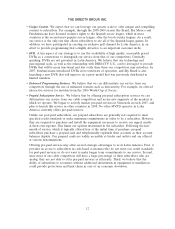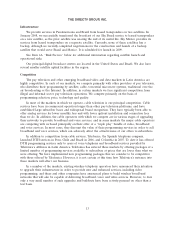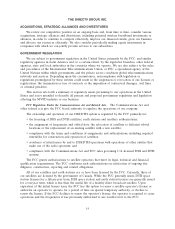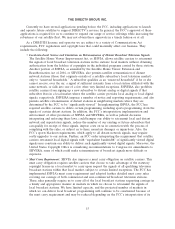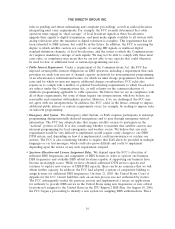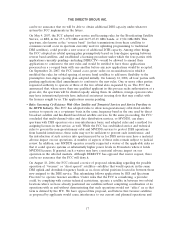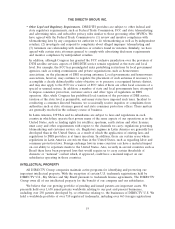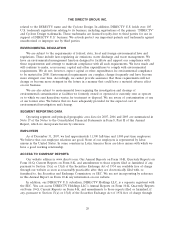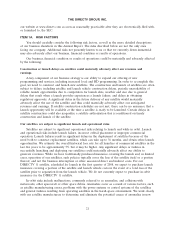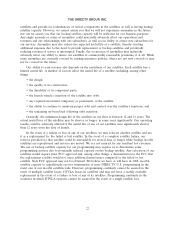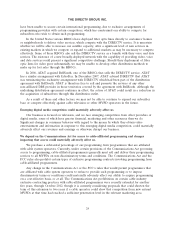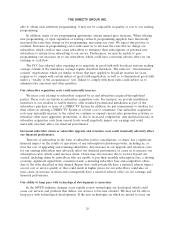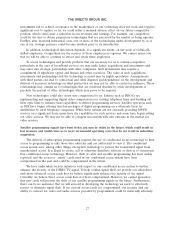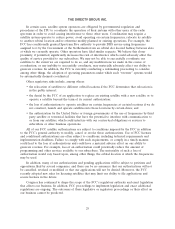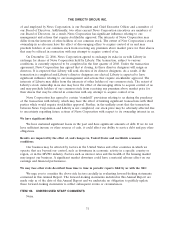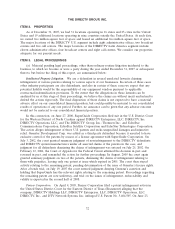DIRECTV 2007 Annual Report Download - page 31
Download and view the complete annual report
Please find page 31 of the 2007 DIRECTV annual report below. You can navigate through the pages in the report by either clicking on the pages listed below, or by using the keyword search tool below to find specific information within the annual report.THE DIRECTV GROUP, INC.
satellites and provide for redundancies of critical components in the satellites as well as having backup
satellite capacity. However, we cannot assure you that we will not experience anomalies in the future,
nor can we assure you that our backup satellite capacity will be sufficient for our business purposes.
Any single anomaly or series of anomalies could materially adversely affect our operations and
revenues and our relationships with our subscribers, as well as our ability to attract new subscribers for
our services. Anomalies may also reduce the expected useful life of a satellite, thereby creating
additional expenses due to the need to provide replacement or backup satellites and potentially
reducing revenues if service is interrupted. Finally, the occurrence of anomalies may materially
adversely affect our ability to insure our satellites at commercially reasonable premiums, if at all. While
some anomalies are currently covered by existing insurance policies, others are not now covered or may
not be covered in the future.
Our ability to earn revenue also depends on the usefulness of our satellites. Each satellite has a
limited useful life. A number of factors affect the useful life of a satellite, including, among other
things:
• the design;
• the quality of its construction;
• the durability of its component parts;
• the launch vehicle’s insertion of the satellite into orbit;
• any required movement, temporary or permanent, of the satellite;
• the ability to continue to maintain proper orbit and control over the satellite’s functions; and
• the remaining on-board fuel following orbit insertion.
Generally, the minimum design life of the satellites in our fleet is between 12 and 16 years. The
actual useful lives of the satellites may be shorter or longer, in some cases significantly. Our operating
results could be adversely affected if the useful life of any of our satellites were significantly shorter
than 12 years from the date of launch.
In the event of a failure or loss of any of our satellites, we may relocate another satellite and use
it as a replacement for the failed or lost satellite. In the event of a complete satellite failure, our
services provided via that satellite could be unavailable for several days or longer while backup in-orbit
satellites are repositioned and services are moved. We are not insured for any resultant lost revenues.
The use of backup satellite capacity for our programming may require us to discontinue some
programming services due to potentially reduced capacity on the backup satellite. Any relocation of our
satellites would require prior FCC approval and, among other things, a demonstration to the FCC that
the replacement satellite would not cause additional interference compared to the failed or lost
satellite. Such FCC approval may not be obtained. We believe we have or will have in 2008, in-orbit
satellite capacity to expeditiously recover transmission of most DIRECTV U.S. programming in the
event one of our in-orbit satellites fails. However, programming continuity cannot be assured in the
event of multiple satellite losses. DTVLA leases its satellites and may not have a readily available
replacement in the event of a failure or loss of any of its satellites. Programming continuity in the
countries in which DTVLA operates cannot be assured in the event of a single satellite loss.
22


